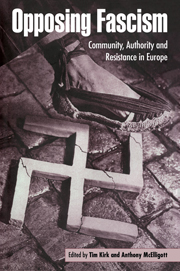Book contents
- Frontmatter
- Contents
- List of contributors
- Preface
- Introduction: Community, authority and resistance to fascism
- 1 The German revolution defeated and fascism deferred: the servicemen's revolt and social democracy at the end of the First World War, 1918–1920
- 2 Dangerous communities and conservative authority: the judiciary, Nazis and rough people, 1932–1933
- 3 The anti-fascist movement in south-east Lancashire, 1933–1940: the divergent experiences of Manchester and Nelson
- 4 Spain 1936. Resistance and revolution: the flaws in the Front
- 5 The Blueshirts in the Irish Free State, 1932–1935: the nature of socialist republican and governmental opposition
- 6 Town councils of the Nord and Pas-de-Calais region: local power, French power, German power
- 7 Structures of authority in the Greek resistance, 1941–1944
- 8 Nazi Austria: the limits of dissent
- 9 ‘Homosexual’ men in Vienna, 1938
- 10 ‘The years of consent’? Popular attitudes and forms of resistance to Fascism in Italy, 1925–1940
- 11 Saints and heroines: rewriting the history of Italian women in the Resistance
- Notes
- Index
6 - Town councils of the Nord and Pas-de-Calais region: local power, French power, German power
Published online by Cambridge University Press: 28 July 2009
- Frontmatter
- Contents
- List of contributors
- Preface
- Introduction: Community, authority and resistance to fascism
- 1 The German revolution defeated and fascism deferred: the servicemen's revolt and social democracy at the end of the First World War, 1918–1920
- 2 Dangerous communities and conservative authority: the judiciary, Nazis and rough people, 1932–1933
- 3 The anti-fascist movement in south-east Lancashire, 1933–1940: the divergent experiences of Manchester and Nelson
- 4 Spain 1936. Resistance and revolution: the flaws in the Front
- 5 The Blueshirts in the Irish Free State, 1932–1935: the nature of socialist republican and governmental opposition
- 6 Town councils of the Nord and Pas-de-Calais region: local power, French power, German power
- 7 Structures of authority in the Greek resistance, 1941–1944
- 8 Nazi Austria: the limits of dissent
- 9 ‘Homosexual’ men in Vienna, 1938
- 10 ‘The years of consent’? Popular attitudes and forms of resistance to Fascism in Italy, 1925–1940
- 11 Saints and heroines: rewriting the history of Italian women in the Resistance
- Notes
- Index
Summary
There is no doubt that an attachment to one's village or town is one of the primary factors which makes up the collective consciousness and one's sense of national identity, a factor which is all the more prominent in border regions. In 1939 two million people lived in the département of the Nord in 669 communes, while in the département of the Pas-de-Calais, 1,800,000 people lived in over 905 communes. The region seemed to have two faces: a densely populated urbanised core comprising 197 communes in the Nord and 108 in the Pas-de-Calais, bordered by rural areas where 50 per cent of communes in the Nord and 80 per cent of communes in the Pas-de-Calais had fewer than 1,000 inhabitants. If one adds the very clear distinction between the ‘classic’ sociologically differentiated principal towns of each arrondissement – Arras, Boulogne, Dunkirk, Valenciennes, Douai – and the towns which had grown up around the textile and mining industries, such as the suburbs of Lille, one begins to get a picture of the great diversities within the region.
In both these départements, the sense of belonging to a local community has, until very recently, prevailed over the sense of regional identity. This parochial loyalty was strengthened by the trials of the First World War, when the Nord, and to a lesser extent the Pas-de-Calais, experienced their first long period of occupation, the aftermath of which had a profound effect on the collective memory.
- Type
- Chapter
- Information
- Opposing FascismCommunity, Authority and Resistance in Europe, pp. 97 - 119Publisher: Cambridge University PressPrint publication year: 1999



